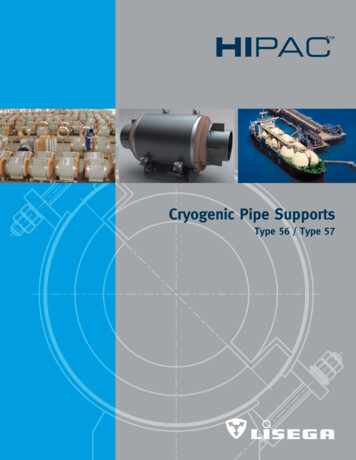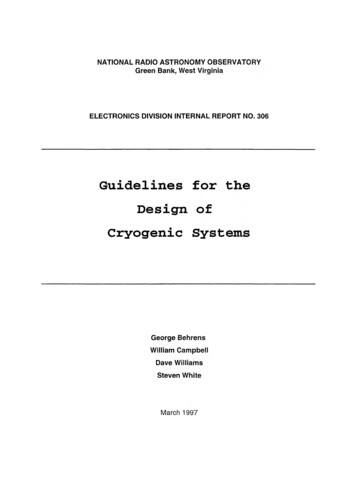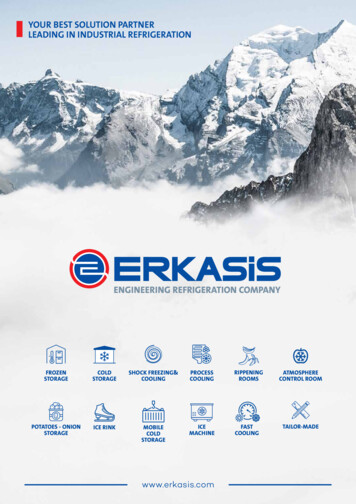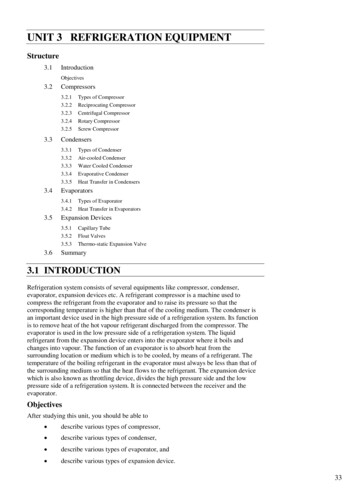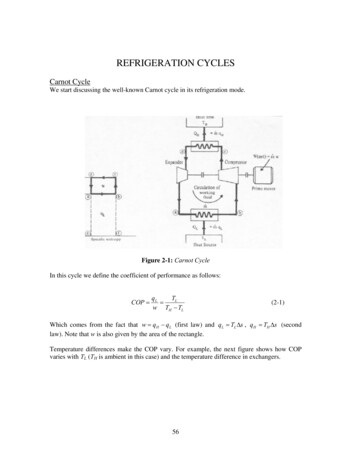
Transcription
Chapter 4Cryogenic Refrigeration SystemsRobert C. Clauss4.1 IntroductionUse of cryogenic cooling by the Deep Space Network (DSN) includes bothopen-cycle refrigeration (OCR) and closed-cycle refrigeration (CCR) systems.The temperatures achieved by these systems range from 1.5 kelvins (K) toabout 80 K, depending upon the type of system used. These cryogenic systemsare used to cool low-noise preamplifiers and some of the antenna feed systemcomponents for the DSN’s receivers. Liquid nitrogen (LN2) was used to coolreference loads (resistive terminations) used for noise temperaturemeasurements, and liquid helium (LHe) was used to cool reference loads andantenna-mounted ruby masers. Russell B. Scott in Cryogenic Engineering [1]explains many aspects of cryogenic technology in terms that are easilyunderstood. Progress since 1959, has given us many types of CCR systems thatcan be used for cooling low-noise microwave amplifiers.Cryogenic refrigeration is a term that may be applied to the process ofcooling equipment and components to temperatures below 150 K. The netcapacity of a cryogenic refrigeration system at a particular temperature is theamount of heat that can be applied to a “cold station” in the system withoutwarming the station above that particular temperature. The cold station may bea bath of cryogenic fluid, or the cold station may be a conductive surfacecooled to the bath temperature to which equipment may be fastened.Cryogenic refrigeration systems are different from the refrigerationequipment we encounter in our everyday environment. The refrigerants used incryogenic systems are often helium (He), hydrogen (H2), or nitrogen (N2).Insulation techniques used to minimize heat leaks into the cooled parts of the159
160Chapter 4systems usually depend on the use of high-vacuum technology, radiationshields, and structural materials with low thermal conductivity. Systems thatuse stored cryogens such as liquid helium, liquid hydrogen, or liquid nitrogen ina container called a “dewar” are usually refilled on a periodic basis. Solidifiedgases (such as hydrogen or methane) can also be used for cooling purposes,much as solid carbon dioxide (dry ice) is used to refrigerate perishable foodsduring shipment, but this has not been done in the DSN.Development of cryogenic refrigeration equipment and systems forlaboratory, military, and commercial purposes began many years beforedevelopment of the ruby masers and other low-noise equipment used in theDSN. This was fortunate, but the personnel developing the DSN’s low-noiseamplifiers did not have all of the knowledge and expertise needed fordeveloping or purchasing cryogenic equipment and systems. There was muchto be learned and many pitfalls to be avoided.Techniques and materials needed for the efficient transfer of electricalpower and microwave signals from a room-temperature environment into acryogenic environment are often not compatible with the techniques needed toprovide adequate thermal isolation. The development of very low-lossmicrowave input transmission lines and waveguides with high thermal isolationwas challenging. Vacuum seals or windows in the transmission lines orwaveguides could be degraded by condensation collecting on surfaces that werecooled by conduction or radiation. Many problems like these were waiting to besolved during the early years of cryogenically-cooled low-noise amplifier(LNA) development for the DSN.Transferring liquid helium into an open-cycle dewar required the use of avacuum-jacketed transfer line. Inadequate insulation in the transfer line wouldcause an expensive failure, wasting the precious liquid helium. Our leader andteacher, Dr. Walter H. Higa, noted, in 1960, that the cost of a liter (L) of liquidhelium was about the same as the cost of a liter of good Scotch whisky. About6 L of liquid helium a day were used for each antenna-mounted maser.Construction or procurement and maintenance techniques for liquid-heliumtransfer lines were learned the hard way.Difficulties encountered during the development and field use of theeventually successful antenna-mounted open-cycle liquid-helium-dewarsystems provided incentives for an alternative approach. Dr. Higa wrote, in a1962 memorandum, “The inconvenience of having to refill a dewar is quiteobvious, and much effort is being expended to perfect a closed-cyclerefrigerator (CCR) for maser applications.” The memo included the photographof a liquid-helium transfer at the apex of a 26-meter (m) antenna shown inChapter 3, Fig. 3-1.The early closed-cycle helium refrigerator systems were not withoutproblems. Early model 210 Cryodynes purchased from the Arthur D. LittleCorporation (ADL) in Cambridge Massachusetts, experienced frequent gear
Cryogenic Refrigeration Systems161failures in the drive units of the refrigerators. The compressors that suppliedhigh-pressure helium gas to the antenna-mounted Cryodynes oftencontaminated the helium with the lubricant used in the compressor. Theexpression “oil carry-over” was used often when reporting Cryodyne warmups (failures). The Joule-Thomson (JT) counter-flow heat exchangers in theCryodyne had been plugged with lubricant that had solidified.Our early learning period of using, maintaining, servicing, repairing, andmodifying CCRs to cool masers on antennas in the field lasted from 1961 to1966. Many problems were solved. Then, the development and production ofthe Model 340 ADL Cryodyne in 1965 provided the world with a reliabletwo-stage Gifford-McMahon (GM) CCR. This 15-K CCR had adequatecapacity for use with a JT counter-flow heat exchanger system developed byDr. Higa and Ervin R. Wiebe [2]. This new CCR provided reliable 4.5-Krefrigeration for DSN masers beginning in 1966.The costs and difficulties experienced developing and using the earlycryogenically-cooled masers seemed high, but the value of the low-noisemasers proved to be more than worth the cost and effort. The expense toprovide and operate larger antennas, or more antennas, that could be used toequal the existing antenna and maser-receiving system’s figure of merit(G / Top ) was more than the cost of building and operating the masers byfactors of tens to hundreds. Advances in cryogenic refrigeration technologycontinued, enabling improvements that helped to maximize the performance ofdeep space missions.4.2 Advantages of Using Cryogenic CoolingCooling microwave components and LNAs to cryogenic temperaturesenables significant reductions in the operating noise temperature (Top ) ofreceiving systems. The sensitivity of a receiving system is directly proportionalto A / Top , where A is the receiving antenna’s effective collecting area. Forexample, when Top 80 K , an array of four identical antennas and receivers isneeded to equal the sensitivity of one such antenna and receiver with a Top of20 K. In 1965, when 26-m-diameter antennas were in operation and 64-mdiameter antennas were being built for the DSN, ruby traveling wave masers(TWM) cooled by 4.5-K Cryodynes were the logical economical choice ofLNAs for DSN receivers.Ruby cavity masers were used on antennas in the Deep SpaceInstrumentation Facility (DSIF) and the DSN beginning in 1960. Theperformance of a maser at DSN frequencies (below 40 gigaherz [GHz])improves as the bath temperature is reduced. The bath temperature term (Tb ) ,is often used for the thermodynamic temperature of a maser whether it is
162Chapter 4immersed in a liquid-helium bath, or cooled by conduction with a closed-cyclerefrigerator. The maser noise temperature is proportional to the bathtemperature, and the maser electronic gain in decibels (dB) varies inverselywith the bath temperature. The temperature dependence of masers is explainedmathematically in Chapter 3. All DSN ruby masers are cooled to temperaturesbelow 5 K. Transistor LNAs used in the DSN are less temperature dependentthan masers and are often cooled to temperatures between 5 and 20 K.Figure 4-1 is a photo of two X-band feedhorns mounted on an X-bandmaser during noise temperature measurements. Top was measured by switchingfrom the ambient load (located between the two horns) and either horn. Themeasurement was used to determine the noise temperature difference of thecorrugated feedhorn and a smooth feedhorn. The corrugated feedhorn resultedin a Top measurement that was 0.1 K lower than that measured with the smoothhorn.A high vacuum inside the CCR reduces heat transfer from the ambientvacuum housing to the cryogenically cooled assembly within the housing. Avacuum window in the X-band signal waveguide entering the CCR seals thesystem from the atmosphere while passing the microwave signals to the LNAsystem within the vacuum housing. The CCR vacuum window withstands theatmospheric pressure and attenuates the incoming signal by about 0.01 dB. Thisloss at 300 K adds 0.7 K to the X-band maser’s effective input noisetemperature as measured at the ambient interface of the maser package.DSN X-band systems use waveguide components, including a diplexer toaccommodate a transmit capability, a filter for out-of-band radio-frequencyinterference (RFI) and transmit signal rejection, and a polarizer preceding thereceiver’s LNA. These components cause loss and noise, thereby degrading thereceiver’s sensitivity. The microwave loss of components made of good qualityelectrolytic copper (oxygen-free high conductivity (OFHC) or electrolytic halfhard) drops by a factor of two when cooled from 290 K to 80 K, and by a factorof three when cooled from 290 K to 20 K. The microwave loss does not changebelow 20 K. These factors (ratios) are independent of frequency in the 2-GHzto 34-GHz range measured. The direct current (dc) resistance of electrolytichalf-hard copper drops by a factor of about 9 when cooled from 290 K to 80 Kand by a factor of about 100 when cooled from 290 K to 20 K. The microwaveloss does not vary as the square root of the dc resistance at cryogenictemperatures. The process used to determine the noise contribution ofcomponents preceding LNAs was described in an earlier chapter and is notrepeated here. Table 4-1 describes the advantages of cooling feed-systemcomponents preceding an X-band maser.
Cryogenic Refrigeration SystemsFig. 4-1. X-band TWM with X-band feed-horns.163
164Chapter 4The system noise temperature (Top ) values shown in Table 4-1 arereasonable for 70-m DSN antennas currently operating at 8420 megahertz(MHz) (X-band) at an elevation angle of 30 degrees (deg) in clear dry weather.The noise from the antenna at the feedhorn input is 12 K. Componentthermodynamic temperatures of 300 K, 80 K, 40 K, 20 K, and 4 K are used.Table 4-1 Top values are calculated at the feedhorn input, in the space justabove the feedhorn.Figure 4-2 shows three of the feed-system components (a) outside of theCCR vacuum housing at room temperature and (b) the same components insidethe CCR vacuum housing at various cryogenic temperatures. The maser inputnoise temperature at the vacuum window ambient interface shown in Fig. 4-2(a) is 3.0 K. The examples used in Table 4-1 gives the combined insertion lossof the three components at the various temperatures. Top , the sensitivitychanges, and the maximum data-rate percentages are calculated values, with100 percent being the reference rate when the feed-system components are atambient temperature. Ambient-temperature feed-system components at S-bandand X-band were used in the DSN in most operational systems prior to the year2002.4.3 Open-Cycle RefrigerationLiquid helium and liquid nitrogen in open-cycle dewars have been used inthe DSN to cool resistive terminations (loads) for calibrations, LNAs, andmicrowave feed-system components. The normal boiling point of liquidnitrogen is 77.395 K at 760 millimeters of mercury (mm Hg) (1.000 atmosphere(atm), 101.32 kPa (kilopascals)), and the temperature varies with vaporpressure from 64 K at 109.4 mm Hg (0.1439 atm, 14.6 kPa) to 84 K at1539 mm Hg (2.025 atm, 205 kPa), and up to a critical temperature of 126.1 KTable 4-1. System noise temperature, receiving system sensitivity change, and maximumdata rate as a function of component physical temperature and mComponentsLoss (dB)System 7290.000100(Reference 00.0815.9023.135205.840.0815.6033.217209.8Maximum DataRate (%)
Cryogenic Refrigeration Systems165(a)(b)FeedhornCCR VacuumWindowFeed-SystemComponentsCCR VacuumWindowLNACCR VacuumHousingSignal OutputSignal OutputFig. 4-2. Feed-system components (a) outside of the CCRvacuum at room temperature and (b) inside the CCRvacuum housing and cooled.at the critical pressure of 25,454.2 mm Hg (33.49 atm, 3393 kPa, or 492.23pounds per square inch absolute (psia)) [1]. Liquid nitrogen is available at arelatively low cost that ranges from about 20 cents to 2 dollars per liter inUnited States currency, depending on the circumstances. Liquid nitrogen hassufficient cooling capacity for many applications.Measurement techniques used to determine the effective input noisetemperature of a receiver (when the receiver is connected to an ambient loadand then to a liquid-nitrogen-cooled load) were described in Chapter 2. Theaccuracy of the measurement is dependent upon the accuracy of the knowledgeof the noise temperature of the loads at the input to the amplifier system. Thetemperature of the liquid nitrogen is dependent upon the pressure of the vaporabove the liquid. When this vapor pressure is determined by atmosphericpressure that supports a 760-mm column of mercury (101.3 kPa, 14.7 psia) atsea level, the temperature of the liquid nitrogen varies with altitude as shown inthe graph below (Fig. 4-3).
166Chapter 4The graph in Fig. 4-3 is based on the vapor pressure data found in reference[1], a portion of which is summarized in Table 4-2 for liquid nitrogen andliquid helium.A reduction in pressure of 12.68 mm Hg (1.69 kPa) from 760 mm Hg to747.32 Hg (101.32 kPa to 99.63 kPa) causes a reduction in the temperature of77.477.2Temperature titude (m)Fig. 4-3. Liquid nitrogen temperature versus altitude.Table 4-2. Altitude, Boiling Point of Liquid Helium and Liquid Nitrogen, and PressureAltitude,feet(meters)Temperature (K)PressureLiquidHeliumLiquidNitrogen(mm) Hg(psia)(inches (1524)4.03175.90263512.2825.0084.7
Cryogenic Refrigeration Systems167liquid nitrogen by 0.1 K. A reduction in the pressure of the same amount causesa 0.0127-K reduction in the temperature of liquid helium.Liquid helium is used to cool components to temperatures below 4.2 K byusing a vacuum pump to reduce the vapor pressure above the liquid helium inthe container. As with liquid nitrogen, liquid helium is readily available on acommercial basis at a higher cost than liquid nitrogen. Today’s cost of liquidhelium ranges upward from 3 per liter in United States currency, depending onthe circumstances.The cooling capability of liquid helium, in terms of watts per liter (W/L), islower than the cooling capability of liquid nitrogen by a factor of about 63. Ittakes 0.716 watt (W) for a period of one hour to convert 1 L of liquid helium at4.2 K to gas. It takes about 45 W for a period of one hour to convert 1 L ofliquid nitrogen to gas. For comparison, it takes about 628 W for a period of onehour to convert 1 L of water at 100 deg C to gas (steam). Dewars used to storeliquid helium and liquid nitrogen are shown in Fig. 4-4.Scott, in reference [1], page 215 writes, “The invention of the vacuuminsulated vessel for liquefied gases by James Dewar in 1892 was a breakthrough in the field of thermal insulation that has not yet been matched byfurther developments. All of the advances since Dewar’s time have beenimprovements on Dewar’s original concept, usually by means of reducingradiant heat transfer by attaining surfaces of higher reflectivity or byinterposing shields which reflect or intercept radiant energy.” These words arestill true today.The dewars shown in Fig. 4-4 (at Goldstone) were commercially availablefor use with liquid nitrogen and liquid helium long before their first use at theDSS-11 DSIF Goldstone Tracking Station in 1960. The forklift planned for thetransportation of dewars did not materialize, but the “HAPPY-TIME RACER”(little red wagon) shown in Fig. 4-4, requested by Walter H. Higa and providedby Charles T. Stelzried, was adequate for the task. These dewars can be used tostore liquid helium and liquid nitrogen for many weeks with minimal loss. Theliquid-helium dewar contains a liquid-nitrogen tank that surrounds the heliumtank to intercept radiation from the ambient environment. Styrofoam containerscan be used to hold liquid nitrogen for short periods. A Styrofoam coffee cupwill hold liquid nitrogen for many minutes, and a Styrofoam container (such asthe one shown in Fig. 4-5) will hold liquid nitrogen for several hours.Figure 4-5 shows manual switching between an ambient load and a liquidnitrogen temperature load. Dr. Walter H. Higa is holding a Styrofoam bucketcontaining liquid nitrogen and a calibration load. Robert S. Latham is facing thecamera, and the author has his back to the camera. The walls of the Styrofoambucket were about 2.5 centimeters (cm) (1 in.) thick, providing adequateinsulation for the liquid-nitrogen-cooled calibration load. The noise temperatureof a cavity maser was being measured.
168Chapter 4Fig. 4-4. Liquid helium and liquid nitrogen dewars on "HAPPYTIME RACER" utility vehiclewith the cherry picker (High Ranger) and cherry-picker fiberglass basket in the background.The cavity maser and dewar system shown in Fig. 3-3 was typical of thedewars used for antenna-mounted operation of masers during the 1960-through1965 time period. The dewar operated during antenna motion as the antennawas moved to track planets or spacecraft from about 10 deg above the easternhorizon to about 10 deg above the western horizon. The hold time for the 3-Lliquid-helium tank was about 36 hours during the antenna-mounted trackingoperations. Refills were accomplished on a daily basis using the High Ranger(cherry picker) partially shown in Fig. 4-4 (and completely shown in Fig. 3-1).
Cryogenic Refrigeration Systems169Fig. 4-5. Noise temperature measurement (manually switching between ambient and liquidnitrogen temperature loads) showing use of styrofoam container for storing liquid nitrogen.This first dewar used to cool a 960-MHz cavity maser to 4.2 K on a DSIFantenna in 1960 was designed by Dr. Walter H. Higa. The dewar and maserwere built and serviced in the field by members of his group. The dewar had aliquid-helium capacity of 3 L and a liquid-nitrogen capacity of 7 L. The liquidhelium tank was surrounded by the liquid-nitrogen tank, and aluminumradiation shields were attached to the top and bottom of the liquid-nitrogentank. This geometry accommodated the application of the magnetic fieldneeded for maser operation by a large permanent magnet located at ambienttemperature, outside of the dewar.Neoprene O-ring seals were used in several locations, between the vacuumhousing and the top and bottom plates, and at the flanges supporting thecryogen fill-tubes and the coaxial transmission line. Neoprene is not imperviousto helium gas. Initial evacuation of the dewar was followed by filling the dewarwith liquid helium. The 4.2-K temperature caused residual gases in the vacuumjacket of the dewar to be trapped (solidified) on the surface of the liquid-heliumtank. The residual gas pressure in the vacuum jacket dropped to less than
170Chapter 41 10–6 torr (1.333 10–4 Pa) for many hours. Unfortunately, small amounts ofhelium gas diffused through the neoprene O-rings and could not be trapped.Within a few days, the accumulation of helium gas in the vacuum jacket of thedewar was sufficient to destroy the insulating properties of the vacuum jacket.A Vac-ion pump that could pump air at the speed of 5 liters-per-second (Lps)and helium at a speed of nearly 1 Lps was installed on the dewar, and this pumpsolved the problem.The 36-hour liquid-helium lifetime of the 3-L tank in the dewar describedabove indicates a total heat leak and maser pump energy load into the heliumbath of about 0.06 W. The liquid-nitrogen lifetime was about the same as theliquid-helium lifetime, indicating a heat load of about 9 W. The liquid-heliumand liquid-nitrogen tanks were refilled on a daily basis. The exiting cold heliumgas could have been used to reduce the amount of heat entering the dewarconductively along the coaxial signal transmission line, but this particulardesign did not take advantage of helium-vapor cooling.The dewar design described above was used for the 2388-MHz singlecavity maser in the 1961 Venus Radar experiment and for several 960-MHzmasers supporting spacecraft missions to Venus and the Moon. A slightly largerdewar with a similar design was used for the two-cavity 2388-MHz maser forthe reception of radar signals from Venus and Mars in 1962 and 1963.Commercially available liquid-helium dewars that were suitable for antennamounted maser operation became available about the time that DSN switchedto cryodyne CCRs for cooling masers. One commercially available liquidhelium dewar was used on a 9-m-diameter antenna at the DSN’s researchstation (DSS-13) to cool a multiple-cavity X-band maser purchased from theHughes Aircraft Corporation in El Segundo, California.4.4 Heat TransferUnwanted heat transfer by radiation and conduction into cryogenicallycooled equipment should be minimized. The 9-W heat load observed on theliquid-nitrogen tank in the dewar designed by Dr. Higa is typical of cryogenicsystems where a cold surface near liquid-nitrogen temperature is about 1/3 of asquare meter (m2). The insides of the ambient-temperature aluminum vacuumhousing were polished mechanically, and the surface emissivity was probablyless than 0.05.Emissivity of the stainless-steel liquid-nitrogen tank was probably about0.1. The emissivity of a cryogenically cooled surface is often degraded withtime. Gases subliming on cold surfaces are capable of raising the emissivity tovalues close to 1. The emissivity of other room temperature surfaces (flanges,extensions, welds, and gaps) might have ranged from 0.1 to 1.Scott wrote [1], “The rate at which a surface emits radiation is given by theStefan-Boltzmann equation,
Cryogenic Refrigeration Systems171W eAT 4(4.4-1)wheree is the total emissivity at temperature T, KA is the area, is a constant having the value of 5.67 10–12 W/cm2, K–4The net exchange of radiant energy between two surfaces is given by theexpression(W EA T24 T14)(4.4-2)where subscripts 1 and 2 refer to the cold and warm surfaces, respectively, andA is an area factor. In the case of cylinders or spheres, it will be taken as thearea of the enclosed (inner) surface; in the case of parallel plates it is obviouslythe area of either surface. E is a factor involving the two emissivities.”Scott’s further explanation [1] of the value of E is not repeated here. Thecomplications of specular reflection and diffuse reflection, gray surfaces, andsurface irregularities can produce errors that seem difficult, if not impossible, todefine. Scott lists the “Emissivity (Total Normal)” of various materials in alater chapter [1], Chapter X, pp. 347 and 348, and explains, “It will be notedthat the emissivity (or adsorptivity) of metals decreases with decreasingtemperature. At a fixed temperature the emissivity must equal the adsorptivity.(If these differed, there could be a net transfer of heat between two surfaces atthe same temperature—a violation of the second law of thermodynamics). Therate of radiant heat transfer between two surfaces at different temperatures,where the geometry permits multiple reflections, depends in a complicated wayupon the emissivities of both surfaces and their absorptivities of the radiantenergy emitted by the opposite surface as well as upon the geometricconfiguration. Fortunately, in the region of the electromagnetic spectrum ofimportance in cryogenic insulation, metals are approximately “gray bodies”;that is, their emissivities (and absorptivities) are almost independent of thewavelength of the radiation, so their emissivities for one distribution of wavelengths are nearly equal to their absorptivities for another distribution. Thus, theformula for radiant heat transfer given in Chapter 6 (p. 148 [1]), will giveacceptable results.”One of the formulae on page 148 [1] is for diffuse reflection when longcoaxial cylinders or concentric spheres are used to determine the value of E.E e1e2Ae2 1 (1 e2 ) e1A2(4.4-3)
172Chapter 4where A1 is the area of the inner surface, A2 is the area of the outer surface, e1is the emissivity of the colder inner surface, and e2 is the emissivity of thewarmer outer surface. This equation is suggested for use with the OCRs andCCRs used to cool preamplifiers in the DSN. The intent here is to provide arough estimate of the radiation heat transfer that must have been part of the9-W total heat load on the liquid nitrogen tank in Higa’s dewar. Heat transferby radiation is an important design consideration for CCRs as well as dewars.Using A1 / A2 0.5 , e1 0.1 , and e2 0.05 gives a value of about 0.0513 forE. Use of this value of E in Eq. (4.4-2) indicates heat transfer rates into theliquid nitrogen tank at 77.4 K of(1) 10.13 W at an ambient temperature of 320 K (116.3 degrees Fahrenheit(deg F)),(2) 7.82 W at an ambient temperature of 300 K (80.3 deg F), and(3) 5.92 W at an ambient temperature of 280 K (44.3 deg F).It is important to consider the environmental extremes to be encounteredwhen designing such a system. The ambient environment at DSN trackingstations can vary between 266 K (19 deg F) and 322 K (120 deg F).A change in the emissivity of the liquid-nitrogen tank from 0.1 to 0.2 wouldcause the radiation heat load from a 320-K surface to increase from to 10.13 to13.62 W. The emissivity of a surface may vary as a function of time andconditions during use. The out-gassing of materials in a vacuum chamber andgases entering through leaks will change the emissivity of the surfaces onwhich these gases are solidified. The emissivity of these surfaces can increaseto values far higher than those of the original clean configuration. Scott [1] liststhe emissivities of smooth ice (H2 O) and glass at 0.94, paper at 0.92, whitelacquer at 0.925, and candle soot at 0.952. Appearances can be deceiving. Awhite, or light-colored surface, is often not a good reflector of radiation at thewavelengths emitted by room-temperature surfaces.Heat transfer from the ambient vacuum housing to the liquid-nitrogen andliquid-helium tanks by conduction through support structures, microwavetransmission lines, waveguides, and wires used for electric circuits must beconsidered. Materials such as nylon, Perspex (polymethylmethacrylate),Teflon (polytetrafluoroethlyne), and fused quartz are very good insulators,especially at low temperatures. The thermal conductivities of materials atvarious temperatures are found in handbooks [3,4] and in graphs by Scott [1].These thermal conductivity values for materials of interest for cryogenicapplications are shown in Table 4-3.
Cryogenic Refrigeration Systems173Table 4-3. Thermal conductivity of various materials, milliwatts/cm K.Temperature 0.0010.0010.001Polystyrene foam--0.330.330.33Teflon0.451.32.3Fused quartz1.31.64.8Alumina52301500480-Sapphire (36 deg toc-axis)11003500011000--Stainless steel (321)32080130140Constantan986170190220Beryllium copper20100350650800Steel, SAE 102013020058065065050–50 lead–tin solder150550505510-Brass231203907001200Aluminum 005002400270022002200Phosphorus deoxidizedcopper75420120019002200Electrolytic tough pitchcopper330013000550040003900Copper, high purity120000105000660041004000Silver, 99.999% pure14400051000520042004180120340580Silver solder-Helium gas-Nitrogen gas-0.620.21---2739.514-1.151.510.180.26The thermal conductivity value for paper-fiberglass-foil layers appears tobe for a composite material that is sometimes called super insulation, but isnormally referred to as multi-layer-insulation. The value shown may apply in aclean, hard-vacuum environment, but not when residual gas, condensed orfrozen, forms a path for heat transfer through the layers.
174Chapter 4Heat transferred by conduction through a material depends upon thethermal conductivity of the material (k), the length (L), and the cross-sectionalarea (A) of the material and the temperature difference ( T) across the length ofthe material. The rate of heat transfer is: A W k T L (4.4-4)The thermal conductivity of materials often varies as a function oftemperature, as shown in Table 4-3. The expression then becomes:W A Thk, dTL Tc(4.4-5)The integral has been solved for many common cryogenic materials andtemperatures [5]. Heat transferred from the higher temperature (Th ) to thelower temperature (Tc ) may be calculated in steps by using numericalintegration with a sufficient number of steps. An example of the temperatureprofile and heat transfer through a 321 alloy stainless-steel rod having a lengthof 30 cm and a cross-sectional area of 1 cm2 is shown in Fig. 4-6.One watt is transferred from 300 K to 4 K, yet the temperature near themidpoint is 200 K, and the temperature is 100 K at a point close to the 4 K end.The same geometry of stainless steel transfers 0.088 W from 70 K to 4 K, andthe 50-K point is near the midpoint. The center conductor of a coaxialtransmission line made of thin-wall stainless-steel tubing stays at a highertemperature for
Cryogenic refrigeration is a term that may be applied to the process of cooling equipment and components to temperatures below 150 K. The net capacity of a cryogenic refrigeration system at a particular temperature is the amount of heat that can be applied to a "cold station" in the system without
